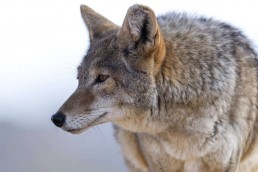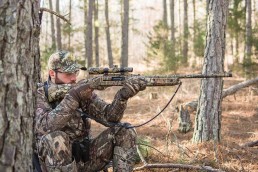Precision Roosting, Real Calling: Ray Eye Tackles Fall Turkeys
SHARE THIS POST
Ray Eye may just be the best turkey hunter in the nation.
I’ve hunted with him in Kansas, Oklahoma and Missouri, and have spent time with him at social settings. He is aggressive in the wild world outdoors. To say that he’s a hard act to follow is putting it mildly. In fact, wherever he’s found, Ray always takes center stage; everyone else just stands back and watches. Ray will do things in the woods that hardly anyone else has the guts to try. This entertaining “aggression” doesn’t fade in the fall, either. He doesn’t run around the woods trying to scatter birds. Like any other time, he overwhelms them with a verbal barrage. That’s the crux of the matter—to hunt like him you’ve got to call like him.
With just a mouth call, Ray can make all the noises of gobblers and hens, some even the birds are still trying to master. He can string these all together and overlap them to sound like a whole frenzied flock.
Eye’s favorite fall method is to roost some birds the evening before the hunt. But he doesn’t just try to figure out which tree they’re using. He wants to know which way they were going when they flew up, because he says they will fly down in the same direction.
The next morning, he tries to get as close as possible before daylight, even as close as 50 yards. He waits until one of the birds makes the first cluck.

Then he takes center stage.
With a series of gobbles, clucks and yelps, he works them into that frenzy before they have rubbed the sleep from their eyes and loosened their grips on the limbs. It works like an alarm clock that’s been set and is now going off at full volume.
When they fly down, Ray really gets aggressive. Much of the time though, one of the gobblers will land well within gun range and the show is over before the bird has time to yawn.
Are you enjoying this post?
You can be among the first to get the latest info on where to go, what to use and how to use it!
When he’s running the ridges trying to locate the more silent turkeys, Ray sometimes uses a slate or box call in conjunction with his mouth diaphragm to create an ongoing crescendo that sound like dozens of excited birds. While calling, he’ll also scratch the leaves with a stick and slap his thigh with a cupped hand to simulate the sounds of wings flapping.
One of the toughest scenarios of fall hunting is when birds forage in open fields. Ray observes them for a while to determine which way they came from and which way they’re headed. Then, he loops around through the woods to set up ahead of them—and you guessed it—and he challenges the dominant gobbler with extremely “aggressive” calling.
He bags a lot of big gobblers during the fall by challenging their pecking order.
“I just call to the gobblers the way they call to each other,” Eye says, as I’ve heard him say many times. “But I do it a little more aggressively.”
I don’t know if Ray has ever ambushed a bird like most of us do during the fall. With absolute aggression, Ray called in and killed his first fall gobbler with a bow back in 1975, and he’s been yelping, clucking and gobbling like a maniac ever since.
Ray could have even been a rock star, if he wanted.
Even with the benefit of seeing his methods in person, I can’t hunt that way, even if alone. I’ve tried it a couple of times, but always felt a little self-conscious. I’m the kind of guy who can sing well in my car, but wouldn’t even know how to begin a “song” in front of an audience and a microphone, let alone wild birds.
Ray, on the other hand, is a consummate showman—without fear. He has proven to me numerous times in dramatic fashion that this super-aggressive turkey “opera” works, and not just in spring, but the fall as well.
MWO
SHARE THIS POST
Did you enjoy this post?
You can be among the first to get the latest info on where to go, what to use and how to use it!
Ron Kruger
Ron Kruger has been communicating the outdoor experience for more than four decades. He has worked as a full-time guide for trout on the North Fork, for crappies and bass on Kentucky Lake and for smallmouths on the Current River. He has served as editor of three outdoor magazines, and owns a patent on a fly/lure called the Desperate Diver.



